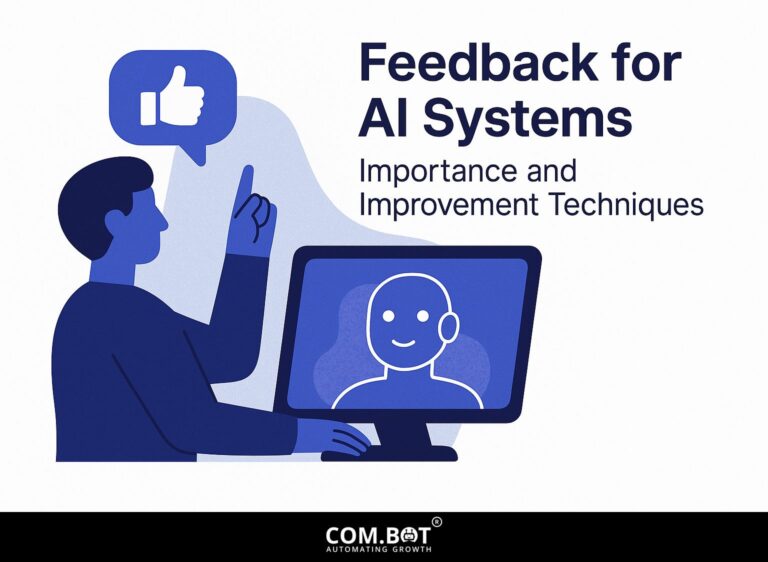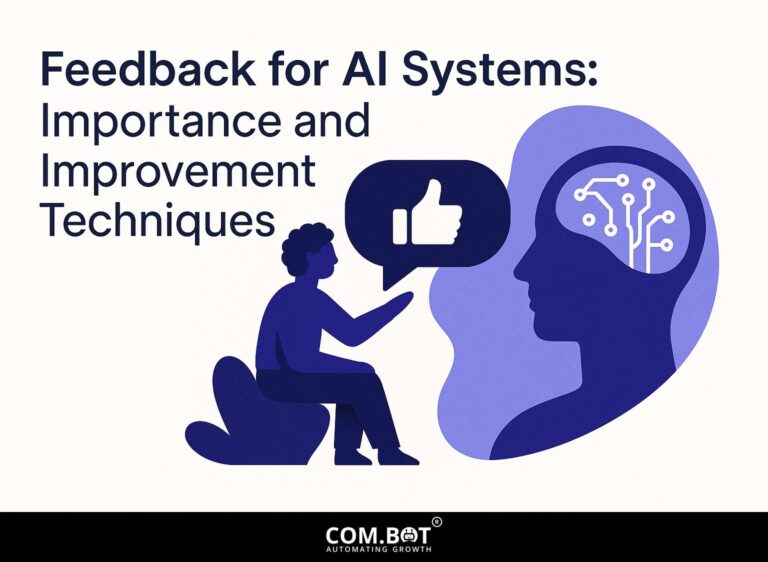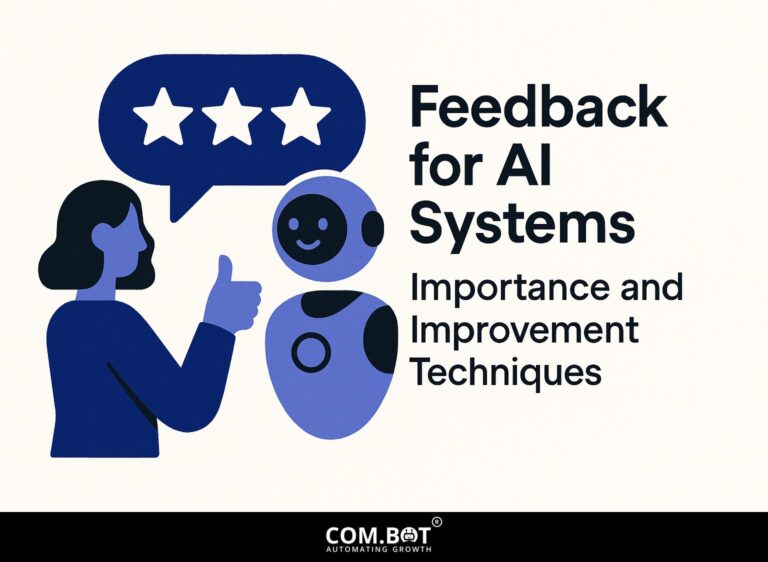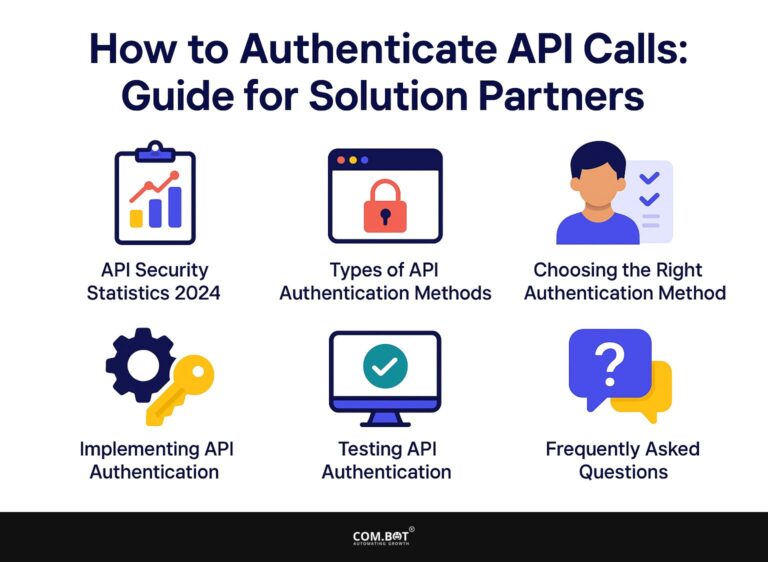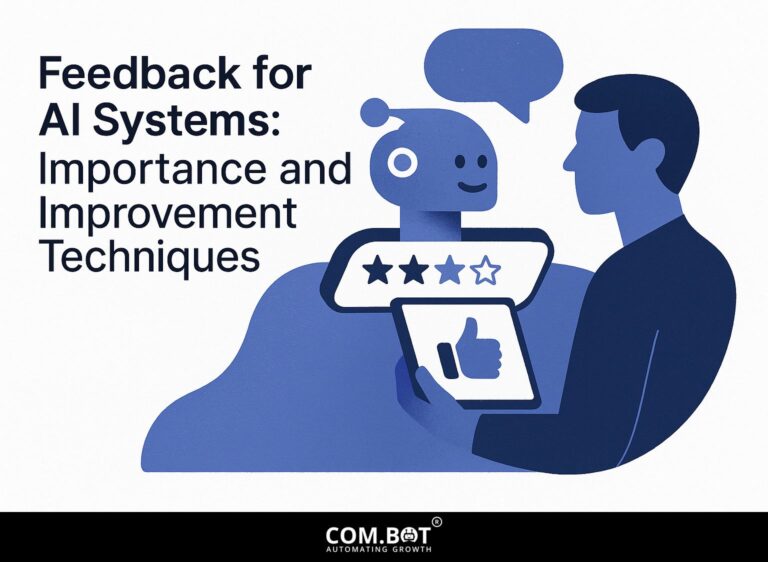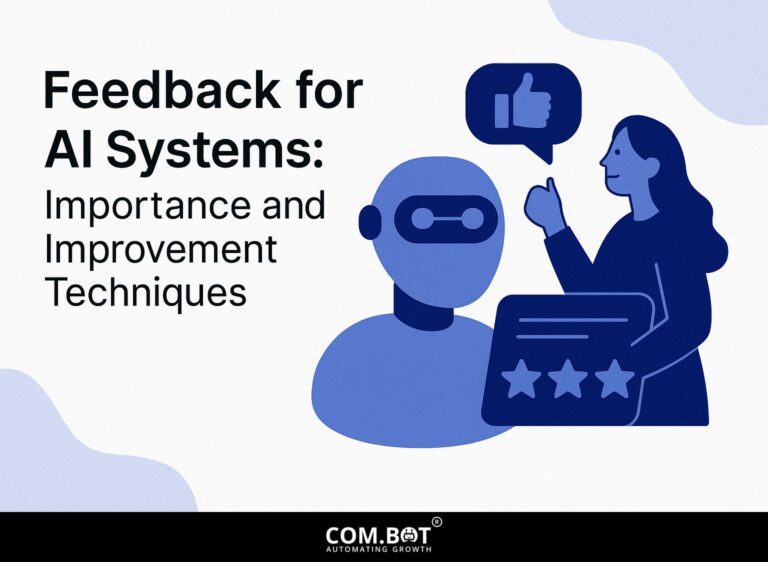Feedback for AI Systems: Importance and Improvement Techniques
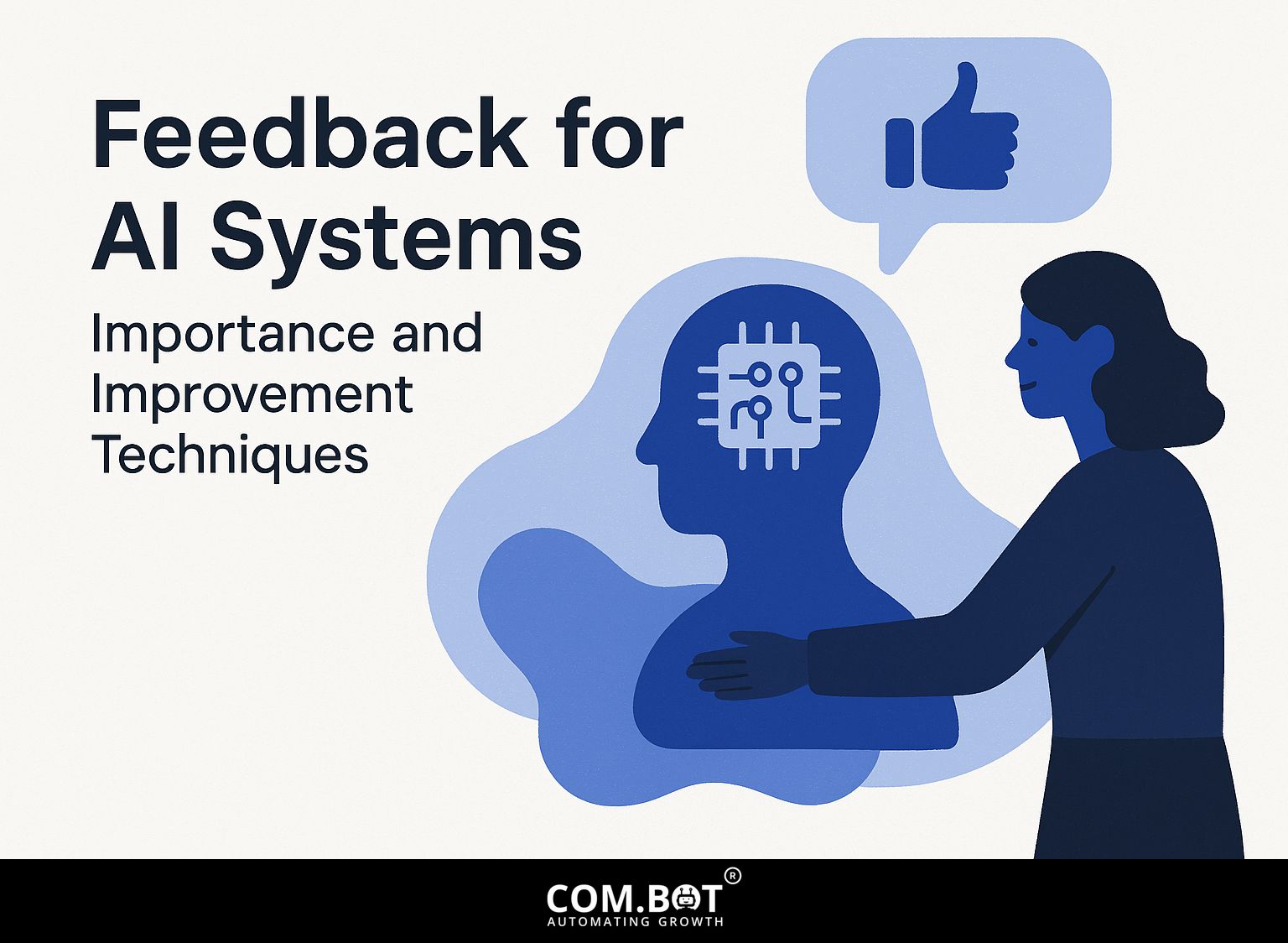
In the fast-paced field of Artificial Intelligence, giving helpful feedback to AI systems is essential for tracking how well they are doing and improving how they engage with users. Using Machine Learning or Deep Learning to gather organized feedback can greatly improve model accuracy and user experience. This article looks at why feedback methods matter and gives useful ways to keep improving, so your AI systems maintain their performance and stay useful.
Key Takeaways:
- 1 Importance of Feedback for AI Systems
- 2 Types of Feedback Mechanisms
- 3 AI Feedback Mechanism Statistics
- 4 Techniques for Collecting Feedback
- 5 Implementing Feedback for Continuous Improvement
- 6 Challenges in Feedback Implementation
- 7 **Upcoming Changes in AI Feedback Systems** AI feedback systems are expected to get much better, becoming easier to use and more helpful. These systems will probably give better answers and do a better job of meeting what users want. As technology moves forward, we can expect more dependable and responsive AI feedback systems that improve how users interact and are happier with the experience.
- 8 Frequently Asked Questions
- 8.1 What is the importance of feedback for AI systems?
- 8.2 How can feedback help improve AI systems?
- 8.3 What are some techniques for providing feedback to AI systems?
- 8.4 Can feedback be harmful to AI systems?
- 8.5 Why is continuous feedback important for AI systems?
- 8.6 How does feedback impact the development of AI systems?
Definition of Feedback
Feedback in AI means the data and information collected from how users interact with the system, which is used to change algorithms and make the system work better.
This method is especially important in recommendation systems used by Netflix and Amazon.
For example, when a user watches a series on Netflix, the platform tracks this interaction and adjusts its content suggestions based on the viewing habits of similar users. Amazon uses customer reviews and previous purchases to make its algorithms better, so they can give suggestions that fit each customer’s preferences.
Tools like Google Analytics help developers collect information about how users interact with their services. This makes it easier to regularly improve features and provide content suited to each person’s likes.
Role of Feedback in AI Development
Feedback is important in AI development, especially in reinforcement learning, where it helps the learning process through user interactions.
In healthcare, for example, continuous feedback can significantly improve diagnostic algorithms. When clinicians give feedback on AI predictions, these comments improve the model’s accuracy over time.
A key example is IBM’s Watson, which improved its ability to diagnose cancer by using information from doctors. By changing the algorithms based on real-world results, Watson got better at predicting, showing how feedback loops allow systems to learn and adjust over time.
This repeated method improves AI performance and builds trust with users.
Importance of Feedback for AI Systems
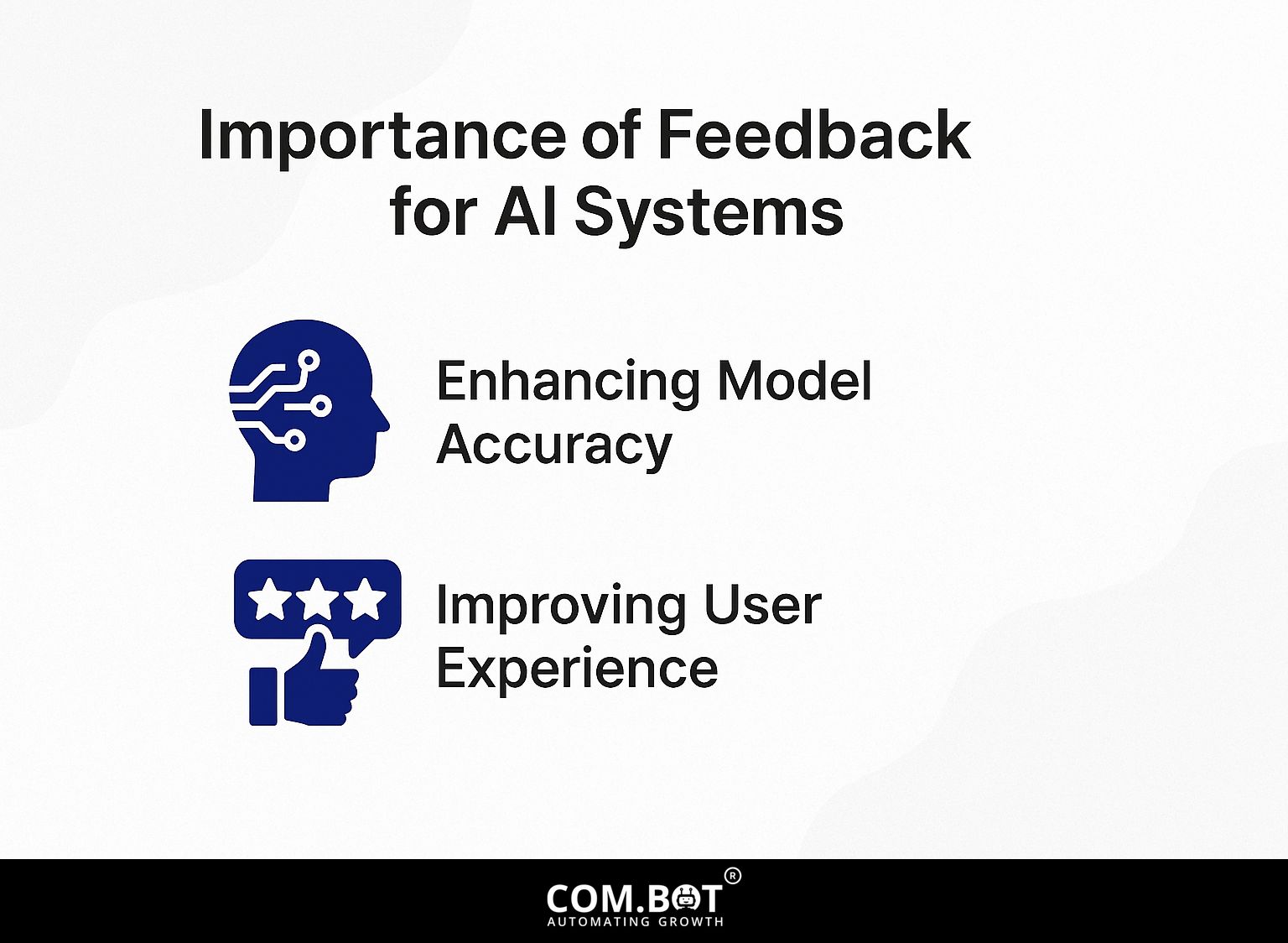
Including feedback systems helps AI models become more accurate and provides a better experience for users. Worth exploring: Feedback for AI Systems: Importance and Improvement Techniques
Enhancing Model Accuracy
Feedback can improve model accuracy by up to 30%, enabling AI systems to make better predictions based on real user data.
To effectively include feedback, start by gathering user inputs using tools like Label Studio. This tool helps with the labeling process by letting you sort and mark data correctly.
Next, carry out ongoing performance checks by using tools like TensorFlow Model Analysis to review model metrics and find areas that need improvement.
Regularly refresh your training datasets with newly labeled data so the model continues to learn and improve. This repeated method improves results and supports a development process that focuses more on user needs.
Improving User Experience
Utilizing user feedback can lead to a 25% increase in user satisfaction scores by tailoring AI systems to meet specific needs.
To effectively gather feedback, implement structured methods such as surveys and A/B testing.
For instance, use tools like SurveyMonkey to create brief surveys gauging user preferences. At the same time, use Optimizely to run A/B tests to see how different interfaces or features perform.
By looking at user feedback and performance data, you can find useful changes that connect with users. Using these ideas will improve user experiences and make sure your AI systems grow to meet user needs.
Types of Feedback Mechanisms
Various types of feedback, whether from people or machines, help improve AI systems and their results.
AI Feedback Mechanism Statistics
AI Feedback Mechanism Statistics
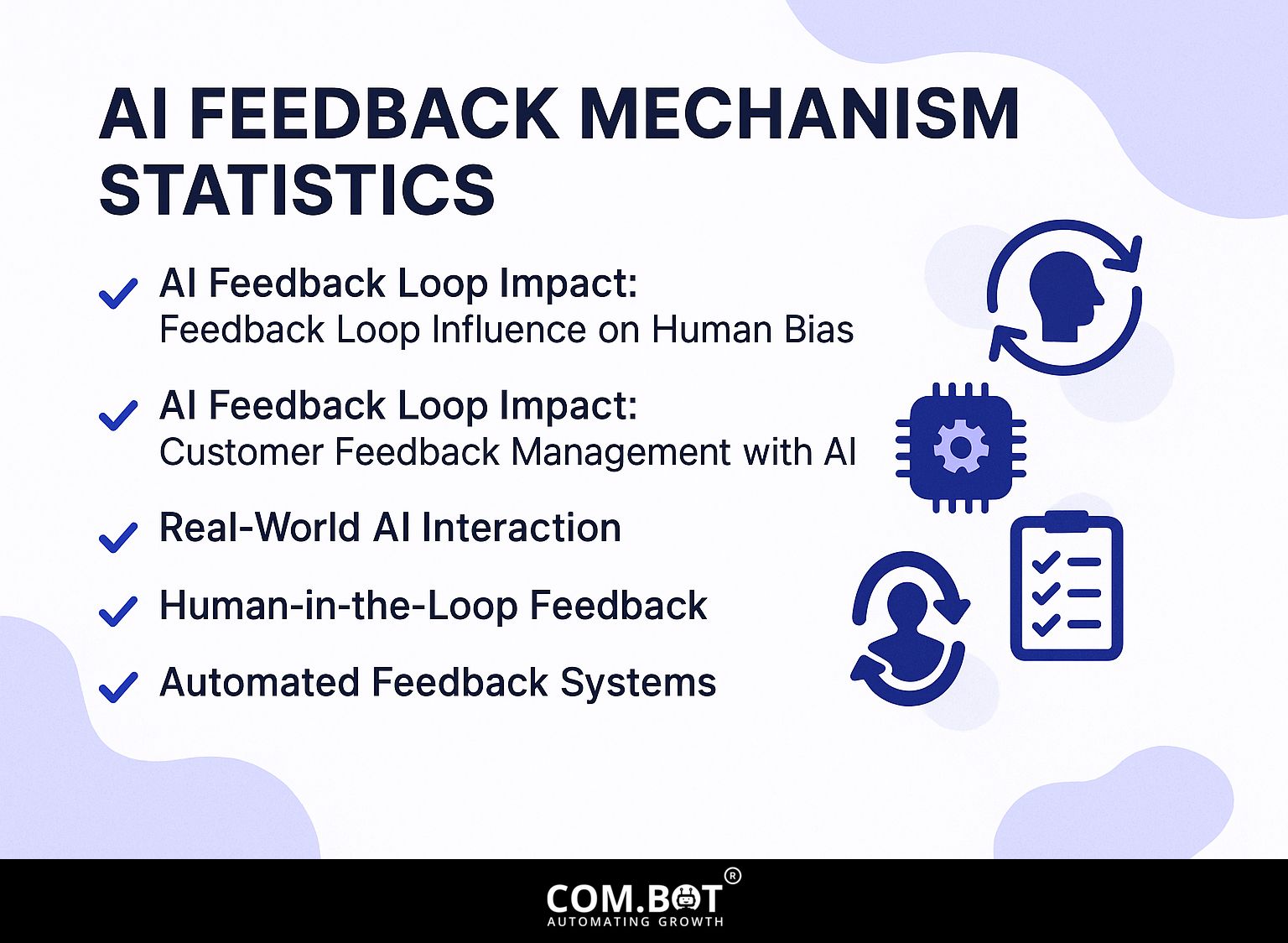
AI Feedback Loop Impact: Feedback Loop Influence on Human Bias
AI Feedback Loop Impact: Customer Feedback Management with AI
AI Feedback Loop Impact: Real-World AI Interaction
The AI Feedback Mechanism Statistics explains the effect of AI in different types of interactions, especially looking at bias and how it affects operations and customer interactions. The data outlines how AI feedback loops affect human biases, customer feedback management, and real-world AI-driven interactions.
AI Feedback Loop Impact on bias reveals a 32.72% increase in bias during human-AI interactions. This major increase shows that AI systems can unintentionally increase existing human biases, likely because of the way AI handles and reacts to data inputs. In comparison, bias in human-human interactions changes by 11.27%, suggesting that AI presents unique challenges and considerations in bias management.
- This disparity is further highlighted when AI is perceived as human, with a 16.84% change in bias rate, indicating that anthropomorphizing AI can alter how biases are expressed or perceived.
In Customer Feedback Management, 80% of companies use AI feedback loops to analyze customer opinions., demonstrating widespread recognition of AI’s capabilities in processing large volumes of data to gauge customer sentiment. This adoption has led to a 15% improvement in customer satisfaction, showing how AI can improve customer experiences by making services more responsive and customized.
- Furthermore, a 20% increase in operational efficiency This shows that AI can make tasks more efficient, decrease mistakes made by people, and improve decision-making, offering great benefits in various parts of a company.
Within Real-World AI Interaction, the selection of white men post-AI interaction increased to 38.2% from a baseline of 32.36%. This suggests that AI systems, possibly influenced by biased data, can impact diversity and selection processes, highlighting the need for more inclusive and representative data sets to mitigate bias.
Overall, the data shows that AI plays an important part in changing how people interact and how businesses run. While AI presents opportunities for improved efficiency and customer engagement, it also poses challenges, particularly in managing and mitigating bias. Using diverse data and ethical AI methods is key to using AI to its fullest while reducing its negatives.
Human-in-the-Loop Feedback
Human-in-the-loop feedback uses input from users directly in AI learning, greatly improving the model’s relevance and accuracy.
In self-driving cars, this method improves systems that make choices. For instance, Tesla uses data from drivers’ inputs to improve its autopilot algorithms.
If a driver takes control during a near-miss situation, that data is analyzed to adjust the vehicle’s risk assessment models. Similarly, Waymo employs a system where human operators review specific scenarios to better understand edge cases, ensuring safety in diverse driving conditions.
These feedback systems help the AI learn from real experiences, making future trips safer and more reliable.
Automated Feedback Systems
Automatic feedback systems simplify data collection, allowing AI models to adjust their functions according to their performance.
For instance, tools like Amazon SageMaker enable real-time monitoring, analyzing data inputs and outcomes.
The system can update models by itself when performance metrics, such as accuracy and exactness, hit certain thresholds. This active method keeps things running well over time.
Using visualization tools like Grafana helps you monitor these metrics visually, making it easier to identify trends and make needed adjustments, ensuring models stay aligned with current data conditions.
Techniques for Collecting Feedback
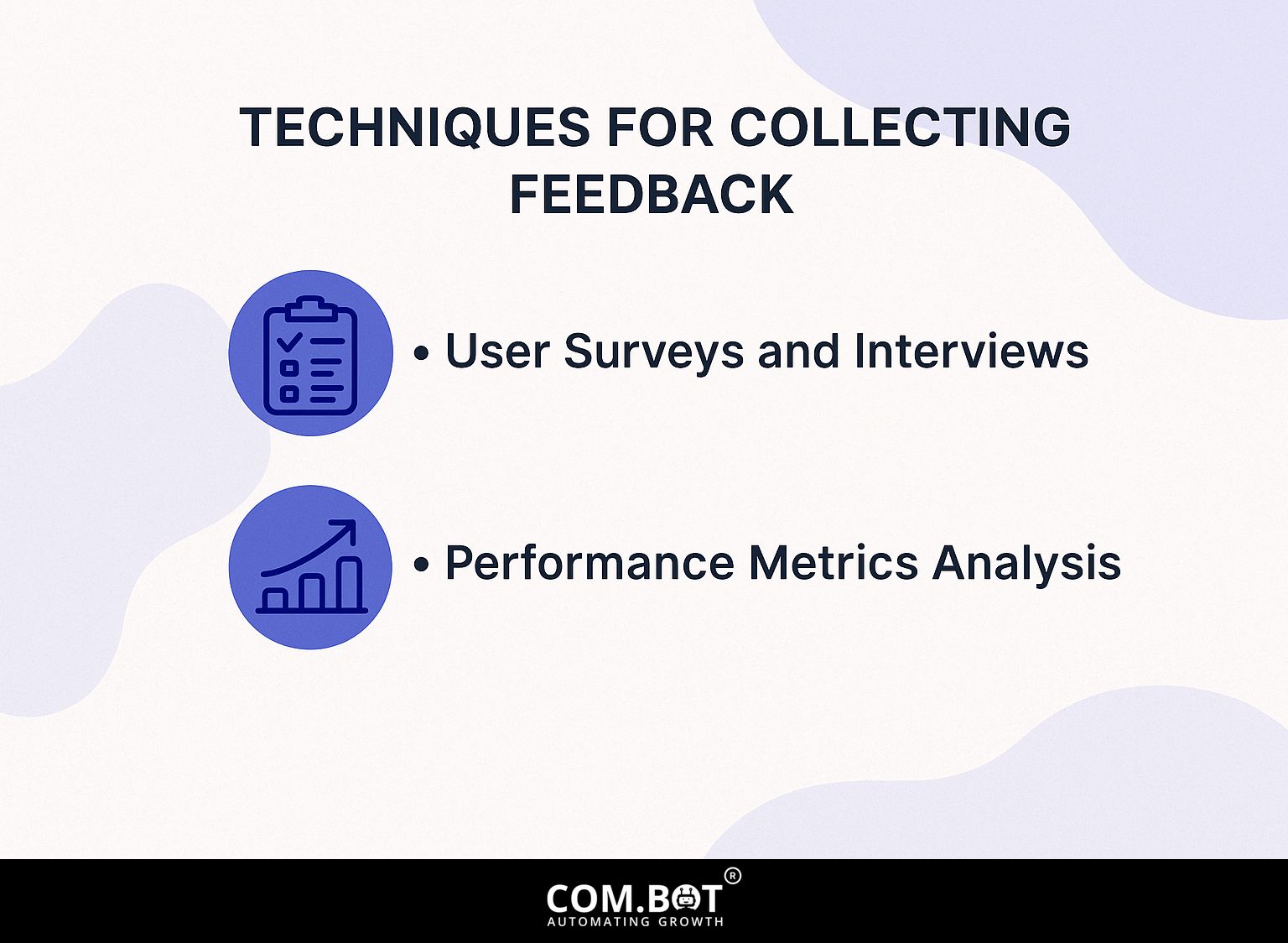
Gathering feedback through user surveys and analyzing performance data are helpful ways to make informed decisions. For a deeper dive into this topic, you can explore various techniques for improving feedback systems in AI environments.
User Surveys and Interviews
Using straightforward questions in surveys can increase responses by 40%, giving clear insights into user preferences.
- To design effective user surveys, start by defining clear objectives for your research.
- Use tools like SurveyMonkey or Typeform, which have simple interfaces and editable templates.
- Make sure your questions include both multiple-choice and open-ended types to get thorough responses.
- Once you have prepared your survey, send it out through email or social media to reach more people.
For interviews, consider tools like Zoom for video calls and Otter.ai for automatic transcription. Make a list of questions to follow, but be open to discussing interesting topics during talks.
Use both numbers and detailed descriptions to fully grasp the topic.
Performance Metrics Analysis
Analyzing performance metrics helps identify trends, revealing areas for improvement and informing necessary adjustments in AI systems.
To properly examine performance measurements in AI systems, using data visualization tools like Tableau can make it easier to grasp complicated datasets.
- Start by loading your data into Tableau.
- Next, design dashboards to show important metrics like accuracy, recall, and exactness.
For example, visualize accuracy trends over time using line graphs to spot anomalies. Use heat maps to show where error rates are high.
Change your AI algorithms using this information, strengthening models that do well and reviewing those that do not.
Implementing Feedback for Continuous Improvement
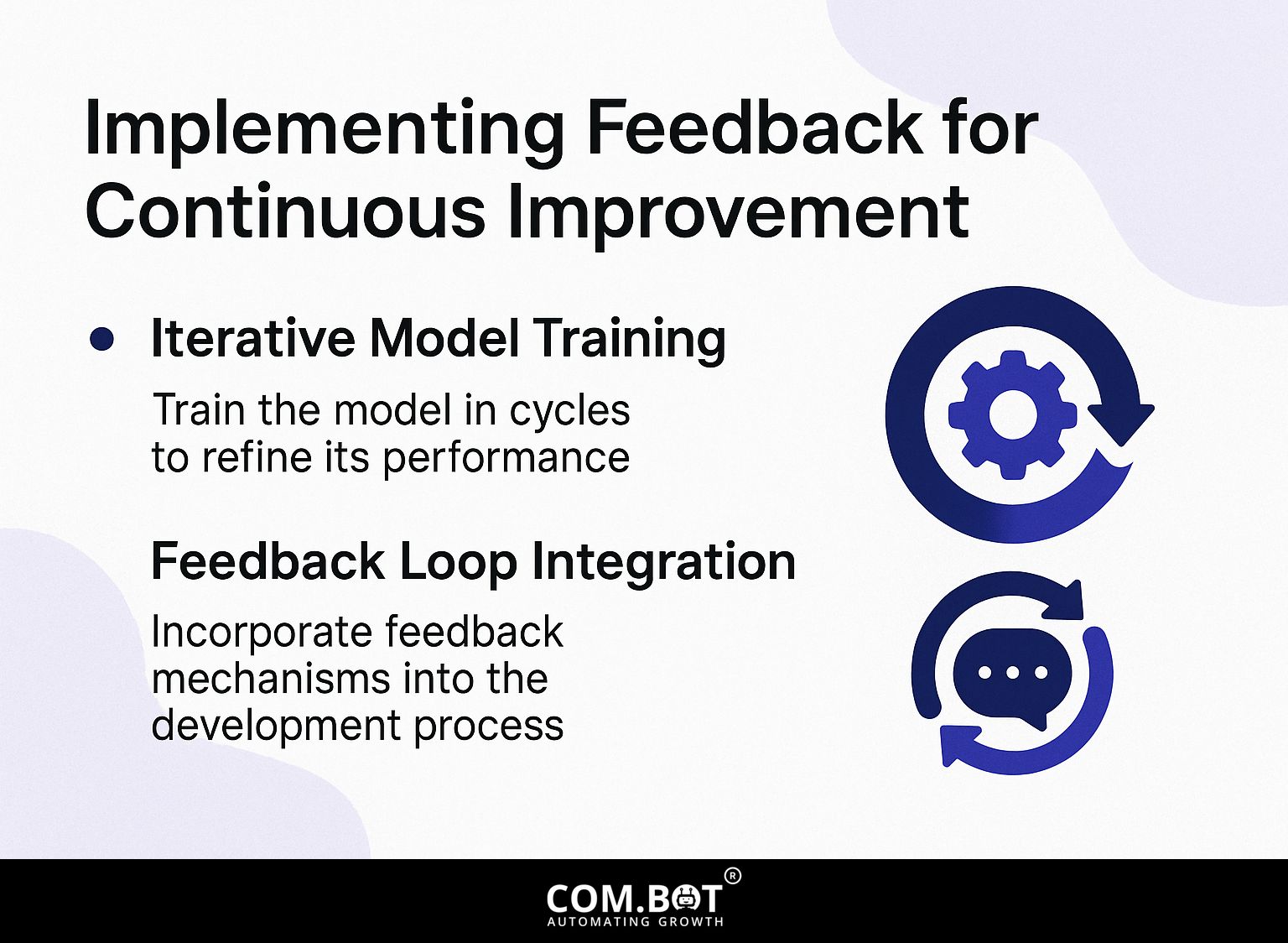
Adding feedback in AI processes is important for continuous improvement and ensuring that systems satisfy user needs. For a deeper understanding, consider this related insight: Feedback for AI Systems: Importance and Improvement Techniques.
Iterative Model Training
Training models repeatedly allows AI systems to update their algorithms using continuous feedback, leading to much better results over time.
In finance, companies like JPMorgan repeatedly train to improve fraud detection algorithms. They gather data from transaction anomalies, which feeds back into their models, enhancing accuracy with each iteration.
Similarly, companies may apply tools like TensorFlow or Scikit-learn to develop predictive analytics. By continuously testing their models against real-world datasets, these organizations can adjust parameters, improving risk assessment by up to 25%.
This process improves performance and strengthens defenses against new financial risks through continuous learning.
Feedback Loop Integration
Adding feedback loops to AI systems creates a setup where algorithms keep getting better based on what users share.
To create effective feedback loops, consider using tools like TensorFlow for machine learning, which allows you to build models that learn from user interactions.
Start by clearly defining the metrics you want to track, such as user engagement or prediction accuracy.
Next, implement a system for collecting real-time data; for instance, using Google Analytics to monitor user behavior.
Schedule routine updates for your algorithms using this data, which will steadily increase your AI’s accuracy in responding.
Challenges in Feedback Implementation
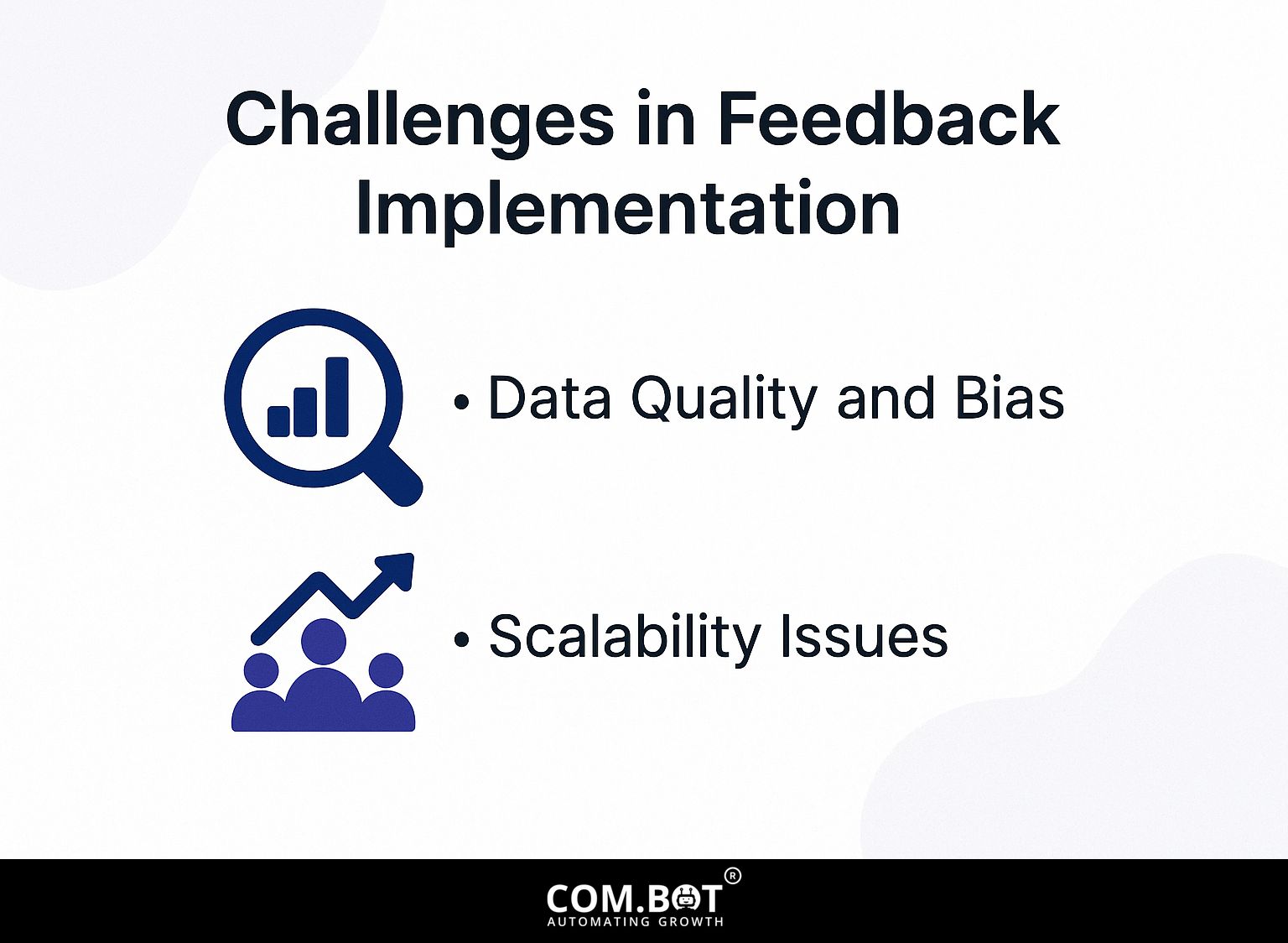
Although important, setting up feedback systems in AI involves challenges like problems with data quality and expanding the system to handle more data. Tackling these hurdles can be more manageable with insights from our comprehensive guide on feedback for AI systems (a hidden gem for improvement techniques).
Data Quality and Bias
Maintaining data quality is paramount, as low-quality data can introduce bias that undermines the accuracy of feedback mechanisms.
To check data quality, use tools like DataCleaner for data validation. These can find errors and missing information.
Adding methods to find bias in your AI models is important. For instance, tools such as AI Fairness 360 by IBM can evaluate bias in algorithms.
Establish a continuous monitoring process where data is regularly reviewed and cleaned to uphold integrity. This approach improves the reliability of your data and improves the performance of your feedback systems.
Scalability Issues
As AI systems grow, adding feedback can be challenging due to more complicated processes and higher demands on resources.
To handle these difficulties well, think about using Kubernetes. It helps set up, expand, and manage application containers without manual effort.
Start by breaking down feedback systems into small, separate parts to simplify updates and testing.
Use tools like Prometheus to check system performance and Grafana to show data metrics.
Use Jenkins for CI/CD pipelines to make updating easier based on feedback, keeping your system flexible.
This method makes your AI system respond faster and use resources more effectively as it expands.
**Upcoming Changes in AI Feedback Systems** AI feedback systems are expected to get much better, becoming easier to use and more helpful. These systems will probably give better answers and do a better job of meeting what users want. As technology moves forward, we can expect more dependable and responsive AI feedback systems that improve how users interact and are happier with the experience.
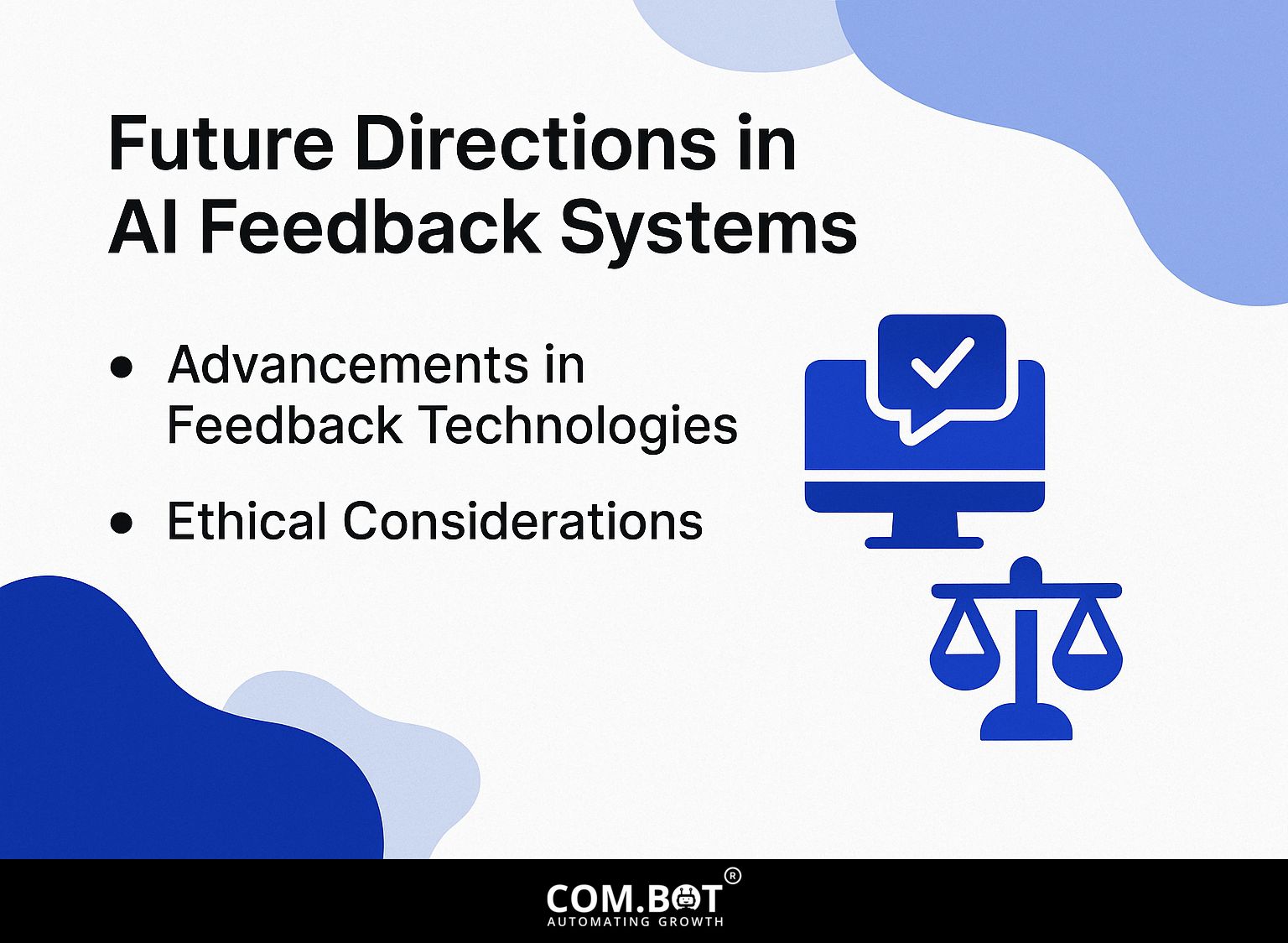
Feedback systems in AI are quickly changing due to new technology and the need to handle data responsibly.
Advancements in Feedback Technologies
Recent advances in feedback technologies, such as deep learning algorithms, make AI systems better at managing user feedback effectively.
For example, using reinforcement learning methods lets AI get better by learning from real-time user interactions. Tools like TensorFlow and PyTorch facilitate the development of these advanced models.
By implementing user-driven feedback loops, systems become more responsive; a chatbot using this technology can analyze user responses and adjust its replies accordingly. This continuous learning method improves accuracy and user satisfaction, demonstrating that good feedback strategies can significantly improve AI performance.
Ethical Considerations
Ethical issues in AI feedback systems are important, especially concerning user data privacy and the risk of feedback being misused.
To keep user data safe, companies should use strong encryption techniques and restrict who can see feedback data. Transparency is equally important; organizations can establish clear privacy policies that outline data collection, usage, and storage practices.
Getting permission from users before gathering feedback helps build trust. Regular audits of the feedback mechanisms help identify vulnerabilities or compliance issues.
Putting these practical plans into action helps keep users safe and builds a good connection between technology companies and their customers.
Frequently Asked Questions
What is the importance of feedback for AI systems?
Feedback is important for AI systems because it helps them learn and get better at what they do. Without feedback, AI systems might keep making the same mistakes or give wrong results, making it hard for them to successfully help with tasks or complete them automatically.
How can feedback help improve AI systems?
Feedback allows AI systems to identify and correct errors or biases in their algorithms, leading to more accurate and fair results. It also gives information on how to improve the system’s features to better serve its users.
What are some techniques for providing feedback to AI systems?
Some techniques include providing explicit feedback through user input, using implicit feedback through user behavior, and incorporating reinforcement learning methods to continuously improve the system’s performance.
Can feedback be harmful to AI systems?
Yes, feedback can be harmful if it is wrong or unfair. This can lead to the perpetuation of incorrect or biased responses, further reinforcing any existing errors or biases in the system. Giving clear and fair feedback helps improve AI systems.
Why is continuous feedback important for AI systems?
Regular feedback helps AI systems to keep learning and get better, making sure they are useful and work well as things change over time. It also allows them to handle new situations and challenges, making them more flexible and productive.
How does feedback impact the development of AI systems?
Feedback is important in building AI systems because it helps developers find and fix errors or biases in the system’s algorithms. It also gives useful information on ways to make the system work better and improve its overall function.
